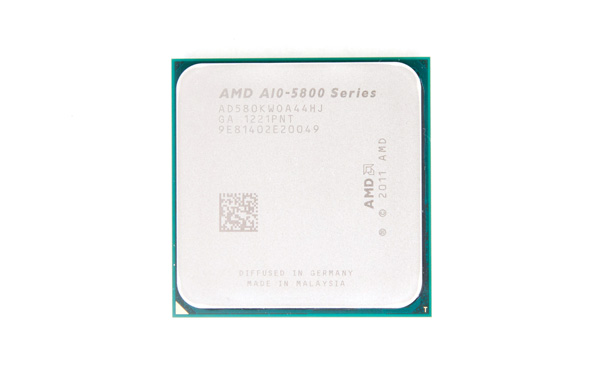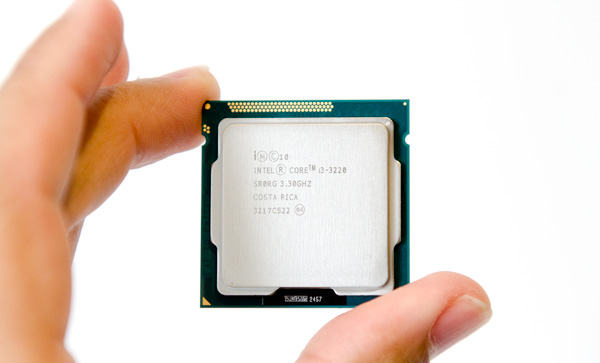AMD A10-5800K & A8-5600K Review: Trinity on the Desktop, Part 2
by Anand Lal Shimpi on October 2, 2012 1:45 AM ESTAlthough AMD's second-generation mainstream APU platform, codename Trinity, launched months ago in notebooks the official desktop launch is today. Rumor has it that AMD purposefully delayed the desktop Trinity launch to clear out unsold Llano inventories in the channel. Although selling APUs in notebooks is pretty easy, convincing desktop users to forgo the discrete GPU option (and ignore Intel) has been a tough battle for AMD. I keep going back to two slides that show us where AMD wants to go and the cores it'll take to get there:

The ultimate goal is this beautiful cohesive operation between CPU and GPU on a single die. That future will require a lot of software support, not only at the application level but also at the OS level. And I'm not talking about Windows 8. We're still far away from this APU dominated future, but AMD is marching in that direction. The second slide shows the x86 cores that we'll see from AMD along the way. AMD is still playing catch-up in the x86 CPU space and it's got a lot of lost time to make up for. There's no hiding the fact this is going to be a multi-year effort to simply get close to Intel's single-threaded x86 performance. Through pricing, leveraging its GPU technology and throwing more transistors at the problem AMD can still deliver competitive solutions, but it's not going to be a walk in the park.
Last week we took a look at the GPU side of the desktop Trinity APUs. We looked at the top end 384-core Radeon HD 7660D configuration as well as the slightly slower 256-core Radeon HD 7560D GPU, both of which easily outperformed Intel's HD 4000 and HD 2500. As far as processor graphics go, Trinity on the desktop maintains a healthy lead over Intel. There's still a place for discrete GPUs but that's pretty much at the $100 and above price points.
Today we're able to talk about pricing and x86 CPU performance among other things. The good news on that front is the most expensive Trinity APU is fully unlocked and is priced at $122:
| AMD Socket-FM2 Lineup | ||||||||
| Modules/Cores | CPU Clock Base/Turbo | L2 Cache | GPU | TDP | Price | |||
| A10-5800K | 2 / 4 | 3.8 / 4.2 GHz | 4MB | 384 cores @ 800MHz | 100W | $122 | ||
| A10-5700 | 2 / 4 | 3.4 / 4.0 GHz | 4MB | 384 cores @ 760MHz | 65W | $122 | ||
| A8-5600K | 2 / 4 | 3.6 / 3.9 GHz | 4MB | 256 cores @ 760MHz | 100W | $101 | ||
| A8-5500 | 2 / 4 | 3.2 / 3.7 GHz | 4MB | 256 cores @ 760MHz | 65W | $101 | ||
| A6-5400K | 1 / 2 | 3.6 / 3.8 GHz | 1MB | 192 cores @ 760MHz | 65W | $67 | ||
| A4-5300 | 1 / 2 | 3.4 / 3.6 GHz | 1MB | 128 cores @ 724MHz | 65W | $53 | ||
| Athlon X4 750K | 2 / 4 | 3.4 / 4.0 GHz | 4MB | N/A | 100W | $81 | ||
| Athlon X4 740 | 2 / 4 | 3.2 / 3.7 GHz | 4MB | N/A | 65W | $71 | ||
Compare this to Llano's launch where the top end SKU launched at $135 and you'll see that AMD is somewhat getting with the times. I would still like to see something closer to $100 for the A10-5800K, but I find that I'm usually asking for a better deal than what most CPU makers are willing to give me.
AMD's competitive target is Intel's newly released Ivy Bridge Core i3 processors. There are only five Core i3s on the market today, four of which use Intel's HD 2500 graphics. The cheapest of the lineup is the Core i3 3220 with two cores running at 3.3GHz for $125. Intel disables turbo and other features (there's effectively no overclocking on these parts), which AMD is attempting to exploit by pitting its Trinity K-series SKUs (fully unlocked) against them. AMD's TDPs are noticeably higher (100W for the higher end K-series parts compared to 55W for the Core i3s). Intel will easily maintain the power advantage as a result under both CPU and GPU load, although AMD's GPU does deliver more performance per watt. Power consumption is a major concern of AMD's at this point. Without a new process node to move to for a while, AMD is hoping to rely on some design tricks to improve things in the future.
At the low end of the stack there are also two Athlon X4s without any active GPU if you just want a traditional Trinity CPU.
The Test
This will be our last CPU/APU review on the current test platform/software configuration. The next major CPU review will see a move to a brand new testbed running Windows 8. As always you can get access to far more numbers than what we report here if you use our performance comparison engine: Bench. Of course if you want to see the GPU and GPU Compute performance of AMD's Trinity APU check out part one of our coverage.
| Motherboard: |
ASUS P8Z68-V Pro (Intel Z68) ASUS Crosshair V Formula (AMD 990FX) Gigabyte GA-F2A85X-UP4 (AMD A85X) Intel DZ77GA-70K (Intel Z77) |
| Hard Disk: |
Intel X25-M SSD (80GB) Crucial RealSSD C300 OCZ Agility 3 (240GB) |
| Memory: | 2 x 4GB G.Skill Ripjaws X DDR3-1600 9-9-9-20 |
| Video Card: |
ATI Radeon HD 5870 (Windows 7) AMD Processor Graphics Intel Processor Graphics |
| Video Drivers: | AMD Catalyst 12.8 |
| Desktop Resolution: | 1920 x 1200 |
| OS: | Windows 7 x64 |













178 Comments
View All Comments
Kaggy - Saturday, October 6, 2012 - link
It would be nice to see some benchmarks on HTML5 and video playback load on the browsers, since nowadays people spend lots of time on their browsers.Silverbuckle - Saturday, October 6, 2012 - link
It looks to me that we are seeing a race to the bottom, and Intel isn't playing. After seeing the results, if I have to start with entry level computer (what ever that means today) the best course would be Intel, i3 with a z77 chip set and a modest card.I have to update one of two computers. The older one will be replaced by this one running the Athlon IIx4 630, stock (It didn't OC worth a damn). It runs CS6 very well. So for my seat, I'll build a new box. I've been waiting to see what to follow. I have two cards available Ati 5670 and Ati 7750. So I can with no additional cost, run the 7750. That makes Intel the only game, because even if I have to lo ball the price, the i3 will equal or surpass the Trinity, using the card. I can upgrade any time all the way to i7 K series.
Given the price of the card if you must include it, you are still positioned well to upgrade the computer with a simple exchange of the processor. Not so for several years with AMD, (best guess here).
Waiting was ok, even though my gut was to go Intel. What I learned is to not be afraid to include the lowly i3.
Chipman1969 - Monday, October 8, 2012 - link
Please redo some of the Trinity benchmarks with 1866 or 2133 ddr3 ram.See http://www.phoronix.com/scan.php?page=article&...
There you can see that Trinity is doing much better with faster ram.
On Amazon G.Skill Ripjaws X DDR3-1600 is 42$ and 2166 is 52$.
medi01 - Tuesday, October 9, 2012 - link
So:"Although likely not the target market for someone buying a Trinity APU, we looked at performance of AMD's latest APU when paired with a high-end discrete GPU. The end result is a total loss for Trinity."
brand new way to piss on AMD's cookies, by Anand The Shameless...
sdoraisw - Friday, January 4, 2013 - link
If you want to compare the idle numbers you should disable the Gfx in IVB processor because trinity doesn't have integrated graphics.not just disable, you need some BIOS switch to power gate the Gfx engine completely. then you can do comparisons.
x7y9 - Saturday, January 12, 2013 - link
I just got a Toshiba S875D-S7350 laptop with AMD A10-4600M processor and tried somesimple benchmarks -- the result was pretty disappointing. Running 4 identical processes
(Ubuntu 12.04) causes the completion time of each process to degrade substantially.
I do some work with generating graphs and analysing them, so basic integer performance
is the most important thing for me.
I ran this simple benchmark and the comments show the results I got:
#!/usr/local/bin/ruby -w
# M1 -- AMD Phenom 2 X4 945 Quad core desktop
# M2 -- Intel Core i3-2310M HP laptop
# M3 -- Toshiba S875D-S7350 laptop with AMD A10-4600M
# M4 -- HP AMD A6 3400M Quad core CPU 1.4-2.3 GHz
# Machine M1 M2 M3 M4
# -------------------------------
# Single run: 158 178 234 292
# 2 parallel: 169 195 283 313
# 4 parallel 205 241 642 354
# (All times in seconds; averaged over the parallel runs)
start = Process.times
a=(0..11).to_a
cnt = a.permutation.inject(0) { |m, _| m + 1 }
finish = Process.times
user = finish.utime - start.utime; sys = finish.stime - start.stime
puts "cnt = %d, user = %ds, sys = %ds" % [cnt, user, sys]
------------------------------
Needless to say, I returned the Toshiba.
.
bomer08 - Tuesday, October 15, 2013 - link
Hello, I would like to know which configuration was used for the 3220 I3. Motherboard, HD (ssd?), RAM, Graphic ... If you have changed something in the BIOS. thanksrobytzel - Thursday, December 26, 2013 - link
hello guys, i have a big question, i own a8-5600k, along with 8gb ddr3 1600mhz, my question is why does my computer lag, but really really lag in games on facebook like farm heroes saga???i cannot explain it to myself, why i can run even crysis 2 on medium-high, but cannot run normally a stupid flash player game!!!please help.happy hollidays!